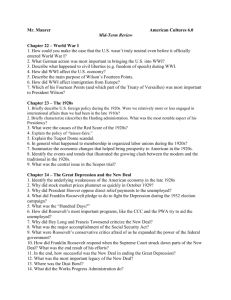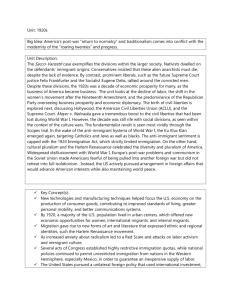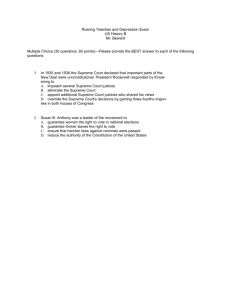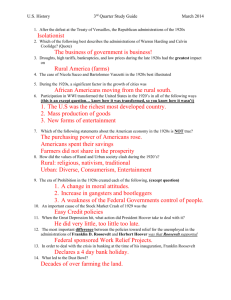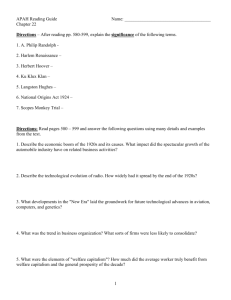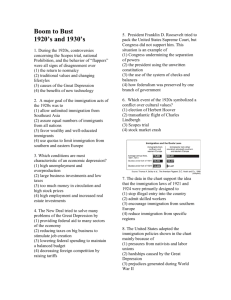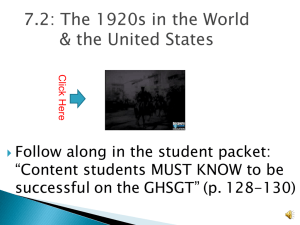27 Which development most clearly illustrates the nativist attitudes
advertisement
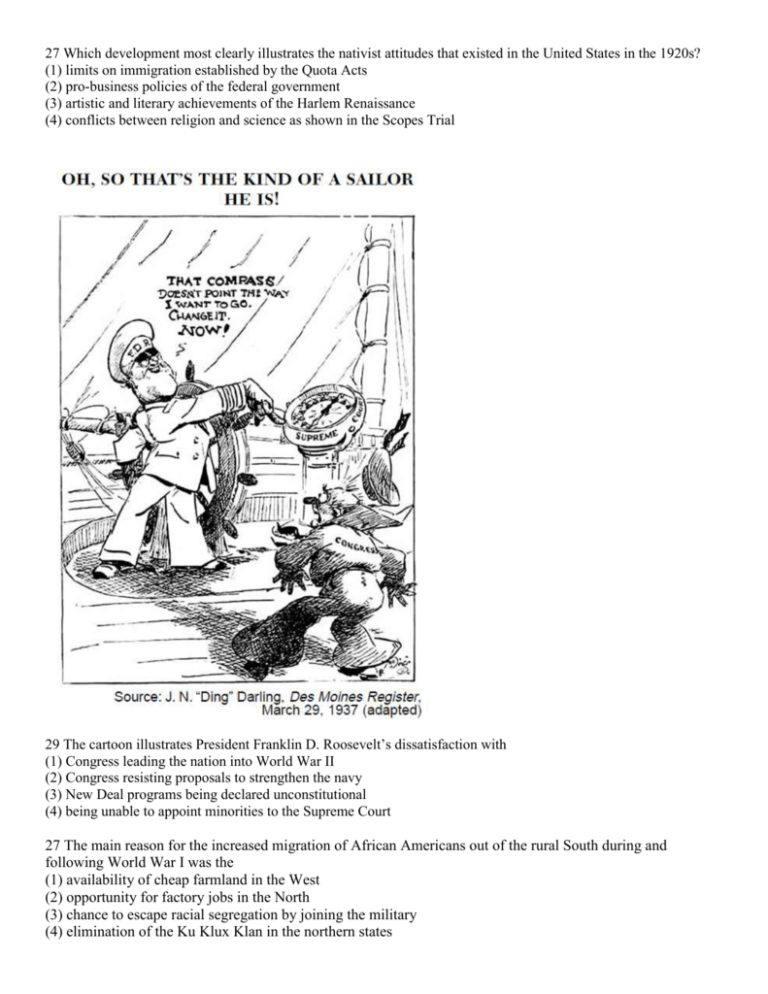
27 Which development most clearly illustrates the nativist attitudes that existed in the United States in the 1920s? (1) limits on immigration established by the Quota Acts (2) pro-business policies of the federal government (3) artistic and literary achievements of the Harlem Renaissance (4) conflicts between religion and science as shown in the Scopes Trial 29 The cartoon illustrates President Franklin D. Roosevelt’s dissatisfaction with (1) Congress leading the nation into World War II (2) Congress resisting proposals to strengthen the navy (3) New Deal programs being declared unconstitutional (4) being unable to appoint minorities to the Supreme Court 27 The main reason for the increased migration of African Americans out of the rural South during and following World War I was the (1) availability of cheap farmland in the West (2) opportunity for factory jobs in the North (3) chance to escape racial segregation by joining the military (4) elimination of the Ku Klux Klan in the northern states 28 National attention was drawn to the Scopes trial of 1925 because the case (1) represented a conflict between science and religion (2) reversed a previous Supreme Court decision on free speech (3) upheld the right of veterans to protest in Washington, D. C. (4) revealed the extent of prejudice against immigrants 29 Which American author was part of the Harlem Renaissance of the 1920s? (1) F. Scott Fitzgerald (3) Langston Hughes (2) Ernest Hemingway (4) John Steinbeck 30 The economic boom of the 1920s was fueled in part by (1) government subsidies paid to farmers (2) tariff reductions on European goods (3) increased investment in the stock market (4) construction by the Tennessee Valley Authority (TVA) 31 What was a major cause of the Great Depression? (1) overproduction and underconsumption (2) a decrease in the supply of consumer goods (3) an increase in demand for imported products (4) an increase in the price of wheat on the world market 32 The New Deal changed American political thinking because it was based on the principle that the (1) economy will fix itself if left alone (2) federal government should attempt to solve social and economic problems (3) political parties must work together to deal with national problems (4) states should take a leadership position in solving social issues 24 In the early 20th century, what was the primary cause of the large-scale migration of African Americans out of the rural South? (1) supply of new housing in the suburbs (2) opportunities for jobs in northern factories (3) availability of cheap land on the frontier (4) absence of racial discrimination in northern states 25 The conflict between science and religion in the 1920s was most clearly shown in the (1) trial of John Scopes (2) arrest of Sacco and Vanzetti (3) nativist reactions to immigration (4) poetry of the Harlem Renaissance 26 One of the major causes of the stock market crash of 1929 was (1) excessive buying of stocks on margin (2) overconsumption of goods and services (3) failure of international banking systems (4) low prices of stocks and bonds 27 Which action did President Franklin D. Roosevelt take that helped organized labor gain strength during the New Deal? (1) requiring the American Federation of Labor to admit skilled workers (2) allowing women to work in government agencies (3) signing the National Labor Relations Act (Wagner Act) (4) selecting John L. Lewis as his Secretary of Labor 30 Many of the songs, movies, and books of the 1930s are similar in that they (1) romanticized urban life (2) relived the bad times of the past (3) helped people escape from the realities of everyday life (4) pointed out the mistakes that led to the Great Depression 49 One common theme in many of the writings of Ernest Hemingway, F. Scott Fitzgerald, and Langston Hughes was (1) the need to regulate business (2) the benefits of mass production (3) optimism for reforms promised by the Great Society (4) dissatisfaction with the American culture of the 1920s 27 What was the major problem facing American farmers during the 1920s? (1) shortage of fertile land (2) overproduction of crops (3) low prices of imported farm products (4) limited labor supply 28 The contributions of Langston Hughes and Duke Ellington illustrate the importance of the Harlem Renaissance to (1) economic growth (2) educational reform (3) the creative arts (4) political leadership 29 The Civilian Conservation Corps (CCC) and the Works Progress Administration (WPA) were both New Deal programs developed to address the problem of (1) excessive stock market speculation (2) high unemployment (3) increased use of credit (4) limited income of senior citizens 30 A major reason that President Franklin D. Roosevelt proposed adding Justices to the Supreme Court in 1937 was to (1) make the Court processes more democratic (2) end corruption and favoritism in handling cases (3) influence Court decisions related to New Deal programs (4) ensure the appointment of members of minority groups 31 Which event led to the other three? (1) migration of 300,000 people to California to find work (2) development of Dust Bowl conditions on the Great Plains (3) passage of New Deal legislation to conserve soil (4) publication of John Steinbeck’s novel The Grapes of Wrath 24 Why did many United States farmers fail to benefit from the economic prosperity of the 1920s? (1) No technological advances were made in agriculture. (2) Levels of farm production declined. (3) Farm exports were heavily taxed. (4) Agricultural goods were overproduced. 25 The Scopes trial of the 1920s dealt with a conflict between (1) communism and capitalism (2) Protestants and Catholics (3) science and religion (4) labor and management 26 Which economic factor contributed most directly to the start of the Great Depression? (1) low worker productivity (2) high income taxes (3) decreasing tariff rates (4) buying stocks on margin Base your answer to question 27 on the cartoon below and on your knowledge of social studies. 27 Which constitutional principle is illustrated in this cartoon? (1) federalism (3) States rights (2) checks and balances (4) executive privilege 28 What was a guiding principle of the New Deal economic policies? (1) Pro-business tax breaks would solve the problems associated with urban poverty. (2) Antitrust legislation would destroy the free market economy of the United States. (3) Rugged individualism must be allowed to solve social inequality. (4) Government must assume more responsibility for helping the poor. 27 The convictions of Sacco and Vanzetti in the 1920s most closely reflected the (1) increase in nativist attitudes (2) federal government’s war on crime (3) corruption of political machines (4) rise in labor unrest 8 What was one cause of the stock market crash of 1929 and the Great Depression that followed? (1) Costs associated with World War I had bankrupted the economy. (2) Speculators had purchased shares of stock on margin with borrowed funds. (3) Federal tax cuts had caused high inflation. (4) Low farm production had weakened banks. 29 During the Great Depression, one way New Deal programs tried to stimulate economic recovery was by (1) raising tariff rates (2) increasing interest rates (3) creating public works jobs (4) lowering the minimum wage Base your answer to question 30 on the cartoon below and on your knowledge of social studies. 30 The cartoonist is commenting on President Franklin D. Roosevelt’s efforts to (1) win congressional approval for his Supreme Court nominees (2) gain Supreme Court support for his legislative program (3) set up a retirement plan for Supreme Court Justices (4) keep members of Congress off the Supreme Court 31 Which geographic area is most closely associated with the Dust Bowl of the 1930s? (1) Great Lakes basin (2) Mississippi River valley (3) Appalachian Mountains (4) Great Plains 25 In Schenck v. United States (1919), the Supreme Court decided that a “clear and present danger” to the country allowed the federal government to (1) establish a peacetime draft (2) restrict first amendment rights (3) suspend habeas corpus (4) limit minority voting rights 28 During the 1920s, Congress passed a series of immigration laws that were primarily designed to (1) increase immigration from Asia (2) expand the workforce for the growing economy (3) limit immigration from southern and eastern Europe (4) prohibit immigration from Latin America 29 During the second half of the 1920s, which economic trend was a major cause of the Great Depression? (1) deficits in the federal budget (2) reductions in tariff rates (3) creation of national and state sales taxes (4) overproduction and underconsumption 30 President Herbert Hoover’s response to the Great Depression was often criticized because it (1) wasted money on new social programs (2) caused widespread rioting and looting in major cities (3) raised taxes on businesses and the wealthy (4) failed to provide direct relief for the neediest persons 31 A major reason for creating the Tennessee Valley Authority (TVA) in 1933 was to (1) build and manage a turnpike in the valley (2) provide health care benefits for southerners (3) encourage African Americans to settle in the valley (4) improve economic conditions in a poor rural region 26 What was one effect of the Bolshevik Revolution (October 1917) on the United States? (1) Nativism increased, leading to the Red Scare. (2) Federal courts banned anti-immigrant groups. (3) The Allied powers needed fewer United States troops. (4) Immigration laws were changed to allow refugees from Russia. 27 What was the effect of the “clear and present danger” ruling established in Schenck v. United States (1919)? (1) placing limits on constitutional freedoms (2) decreasing the president’s powers during wartime (3) limiting the hours women could work in industry (4) upholding the right of states to regulate child labor 28 The Harlem Renaissance promoted African American culture by (1) increasing factory employment opportunities for minorities (2) encouraging immigration from Africa (3) focusing attention on artistic contributions (4) bringing an end to legalized racial segregation Base your answer to question 32 on the cartoon below and on your knowledge of social studies. 32 Which statement about President Franklin D. Roosevelt’s plans for a second term most accurately expresses the main idea of the cartoon? (1) Congress will give President Roosevelt a free hand to lead the nation. (2) The American people will trust Congress to control President Roosevelt. (3) President Roosevelt will seek direction from the people. (4) The Great Depression will no longer be a serious concern. 29 During the 1920s, the United States changed its immigration policy by passing new laws that (1) provided incentives to attract more immigrants to factory jobs (2) encouraged Chinese immigrants to enter the country (3) allowed unrestricted immigration of war refugees from Vietnam (4) established quotas that reduced the number of immigrants from certain countries 30 President Franklin D. Roosevelt believed that declaring a bank holiday and creating the Federal Deposit Insurance Corporation (FDIC) would help the nation’s banking system by (1) restoring public confidence in the banks (2) reducing government regulation of banks (3) restricting foreign investments (4) granting tax relief to individuals 31 The Social Security Act (1935) is considered an important program because it (1) brought about a quick end to the Great Depression (2) provided employment for those in need of a job (3) established a progressive income tax (4) extended support to elderly citizens 50 Which book describes how the Dust Bowl of the 1930s affected farmers of the Great Plains? (1) How the Other Half Lives (2) The Jungle (3) The Grapes of Wrath (4) Silent Spring

